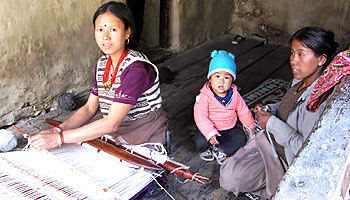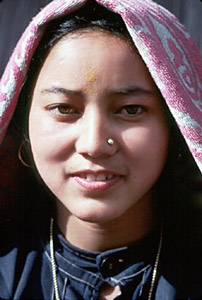 Being a nomadic people with regular trade with Tibet, most of the men folk had to be away from home for long periods. As a result the Bhotia women are self-reliant, sturdy and independent. They are equals with their men in work and play and are good wives and competent mothers. For the intermingling of the sexes, the Bhotias have a unique system. Unmarried boys and girls in the community and married girls who are childless have a club, which is located in a house called rangbang kuri (club house). When they meet here, the whole night is passed in singing and dancing. The rangbang plays an important part in bringing young people together.
Being a nomadic people with regular trade with Tibet, most of the men folk had to be away from home for long periods. As a result the Bhotia women are self-reliant, sturdy and independent. They are equals with their men in work and play and are good wives and competent mothers. For the intermingling of the sexes, the Bhotias have a unique system. Unmarried boys and girls in the community and married girls who are childless have a club, which is located in a house called rangbang kuri (club house). When they meet here, the whole night is passed in singing and dancing. The rangbang plays an important part in bringing young people together.
The Bhotias are not stringent about marriage and a woman can remain unmarried if she so chooses. In fact, many women prefer to remain unmarried if they cannot find a suitable match. Monday is considered inauspicious for weddings and none take place on this day. At a wedding, pretence is always made that the bride will never go to her husband voluntarily and has to be carried by force.
As a part of the celebrations the bridegroom`s father invites the bridegroom`s friends for a feast at night. Later, the party proceeds to the bride`s village and carries her away from the rangbang for a short distance. Here they call the bridesmaids to join them and then proceed to the bridegroom`s house. On entering the house, the village elders produce their dalangs or cones of dough with liquor, which are given to the bride and bridegroom for consuming. This is followed by a feast. The next ceremony, the formal rite of datu, then ensues. The bridegroom and the bride exchange the dough and fish given them and by this they are bound in wedlock.
Death ceremonies are more elaborate. Children who have not outgrown their milk teeth are buried, the head placed northwards. Those dying a bit older are cremated. The dead body is placed in a white bag, with the knees touching the chin. The bag is then placed on a bier. A white cloth - cotton for a man and woolen for a woman - is tied to the front of the bier so that the spirit of the deceased can be guided in the next world.
The funeral procession is led by a young boy or girl holding burning faggots, followed by the women, then the bier and finally the villagers carrying fuel for the cremation, which is usually held by the side of a stream. The corpse is placed facing east and before it is burnt, the cloth bag is slit and a piece of precious metal is put into the mouth to purify the corpse. A bone of the deceased is collected on the next day and placed in a hole in the place in the village where the bones of dead persons are interred. The same night, a funeral feast is given and a special provision of food is made for the departed person: some rice and other food are put just outside the deceased`s house, thrice daily until the dhurung ceremony is over.
 In Garhwal, the Bhotias are known as Marchas and in Uttarkashi as Jads. They can be roughly classified as belonging to five groups - the Mana and Niti (in Garhwal) and the Johar, Darma and Byans (in Pithorgarh District). They live at very high altitudes and it is believed that Dwan in Johar is the highest inhabited spot in the world, at an altitude of over 3,050 metres.
In Garhwal, the Bhotias are known as Marchas and in Uttarkashi as Jads. They can be roughly classified as belonging to five groups - the Mana and Niti (in Garhwal) and the Johar, Darma and Byans (in Pithorgarh District). They live at very high altitudes and it is believed that Dwan in Johar is the highest inhabited spot in the world, at an altitude of over 3,050 metres.
Before the Chinese took over Tibet, the Bhotias, who are a shrewd and enterprising people, carried on wide-scale trade with Tibet in wool, women, fabrics and sheep-skins. Their agriculture is primitive. Their main produce is jute. Their sheep and goats are their mainstays which provide them with wool, hide and fur.
At Sera reside the Ban Rajis. The Ban Manas never leave their forest dwellings and even the local people have no contact with them. They have wheatish complexion and are short in stature. They trade in articles made of wood and leave them at the doorsteps of the houses of the villagers place rice, wheat, and other foodstuffs which are taken away by the Ban Rajis.
Ethnologically, there is meagre information about the Rajis but a legend has it that when the world began, two Rajput brothers had a fixed abode. The latter insisted that there could be only one raja there, the elder brother retired to the forests and the Ban Rajis are said to be his descendants.
Since the Rajis profess royal descent, they refuse to salute anybody and even speak of the rajwar of Askot as their younger brother. Hinduism has influenced them and they worship Nanda Devi but they also worship their own set of gods.
Marriages are arranged by parents who exercise complete control over their children and there are no priestly ceremonies or feasting. The bridegroom is normally given a present or goats. Polygamy is practised sometimes but child marriage and widow marriage are rare. They have hardly any property, excepting a few cattle. The inheritance goes to the sons.
















